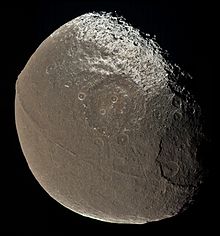This article has multiple issues. Please help improve it or discuss these issues on the talk page. (Learn how and when to remove these messages)
|



Equatorial ridges are a feature of at least three of Saturn's moons: the large moon Iapetus and the tiny moons Atlas and Pan. They are ridges that closely follow the moons' equators. They appear to be unique to the Saturnian system, but it is uncertain whether the occurrences are related or a coincidence.
Iapetus was discovered by Italian-born French astronomer Giovanni Domenico Cassini in October 1781; Atlas was discovered from the images taken by Voyager 1 during its flyby of Saturn in November 1980;[1] while Pan was discovered by Showalter in the same year as Atlas. Lastly, the very small moon Daphnis, discovered by the Cassini in 2005, also appears to have such a ridge.
All three equatorial ridges were discovered by the Cassini spacecraft.[citation needed]
The ridge on Iapetus is nearly 20 km wide, 13 km high and 1,300 km long. The ridge on Atlas is proportionally even more remarkable given the moon's much smaller size, giving it a disk-like shape. Images of Pan show a structure similar to that of Atlas.[citation needed]